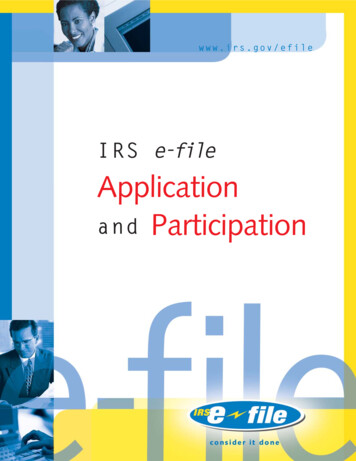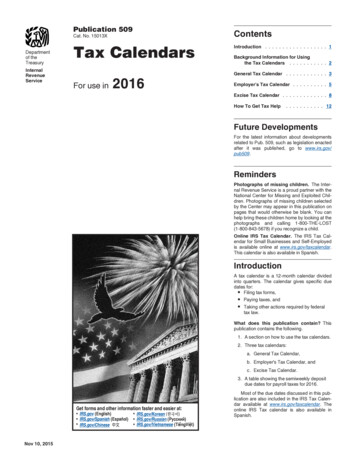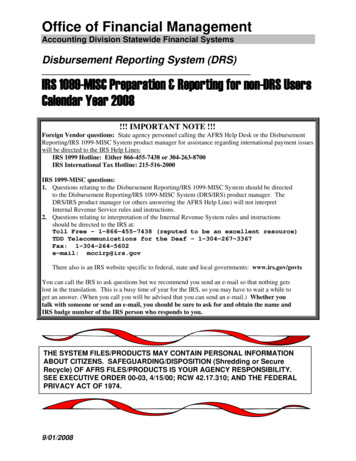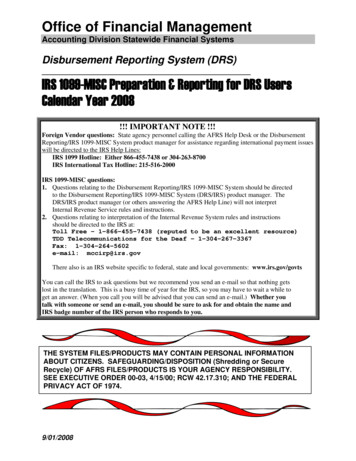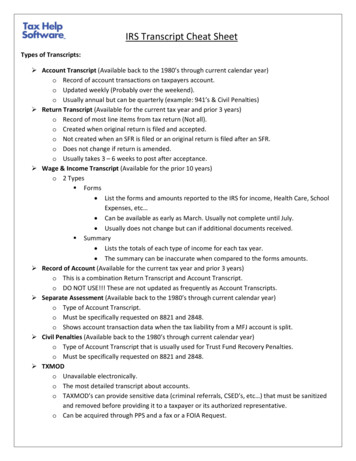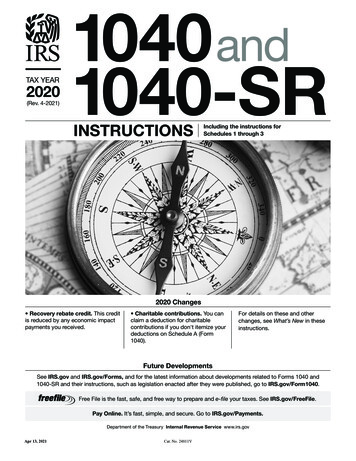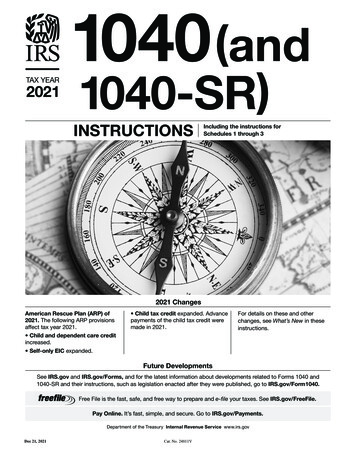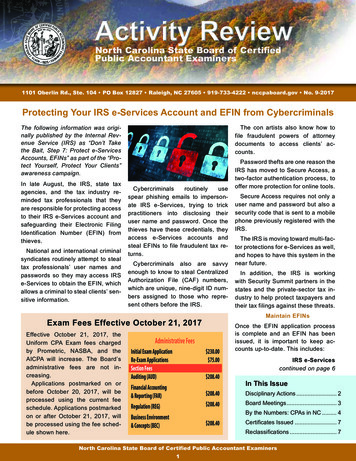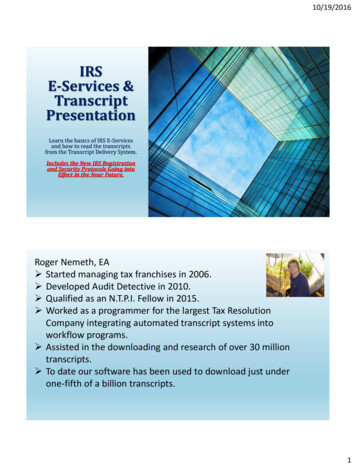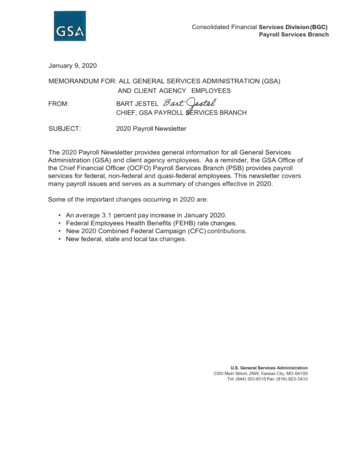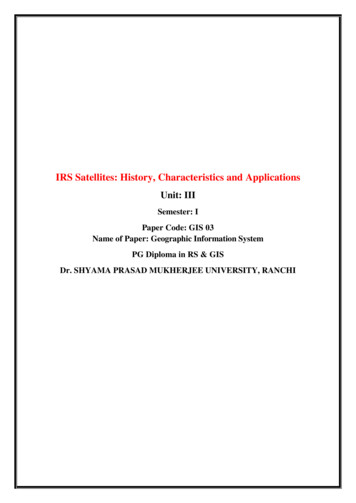
Transcription
IRS Satellites: History, Characteristics and ApplicationsUnit: IIISemester: IPaper Code: GIS 03Name of Paper: Geographic Information SystemPG Diploma in RS & GISDr. SHYAMA PRASAD MUKHERJEE UNIVERSITY, RANCHI
IRS Satellites: History, Characteristics and ApplicationsSince inception, The Department of Space (DOS) has the vision to harness space technologyfor national development, while pursuing space science research and planetary exploration. Toactualize this vision the DOS has evolved and focused on four distinct fields –(i) to develop indigenous capability for launching vehicles and the development andoperationalisation of Polar Satellite Launch Vehicle (PSLV) and development of Geosynchronous Satellite Launch Vehicle (GSLV) are significant achievements in this field;(ii) the multi-purposeIndianNationalSatellite (INSAT) programmeforthetelecommunication, broadcasting, development of education and meteorology etc;(iii) the Indian Remote Sensing Satellite (IRS) programme for observation of earth surfacefeatures for various developmental purposes, and(iv) Research, Trainingand advancement in Space Sciences and Technologies for betteracquisition and processing of remotely sensed digital data and to convert it into information forthe socio -economic benefit of the country.India’s first indigenously designed and developed experimental satellite the Aryabhata (namedafter the famous ancient astronomer and mathematician) was successfully launched by a SovietKosmos-3M rocket on April 19, 1975 from Kapustin Yar. Starting from Bhaskara-I, the FirstExperimental Earth Observation Remote Sensing Satellite built in India and launched fromVostok, Russia (former USSR), in 1979 to the latest Cartosat 2 Series satellite launched (byindigenous launch vehicle PSLV) in 2018 a variety of sensors are operating in visible, infrared,thermal and microwave spectral regions, including hyper-spectral sensors to acquire digitaldata at spatial resolutions ranging from 1 km to a meter have been built and launchedindigenously along with satellites of developed nations. Indian Space Research Organisation(ISRO) on 15 February 2017 in a single launch successfully fixed 104 satellites in orbits; outof these 3 satellites wer e Indian and rest were of the developed countries mainly the USA.Within a limited time period indigenous PSLV and GSLV have established huge number ofIRS and INSAT series satellites in orbits. The facilities to receive and process the remotelysensed data have been established in different parts of India along with various internationalground stations. The focus of the present article is the Indian Remote Sensing Satellite (IRS)1series along with sensor characteristics and applications. In the early experimental phase,
Bhaskara-1(June 7, 1979) and Bhaskara-2 (November 20, 1981) provided data for landapplications on the basis of two types of sensor systems – (i) television camera with spatialresolution of 1 km operated in visible and near infrared bands and (ii) Satellite MicrowaveRadiometer (SAMIR) for oceanic and atmospheric applications. Following the success of thisexperimental phase, India initiated an indigenous Indian Remote Sensing Satellite (IRS)programme to support national and sub national economies in the areas of agriculture, soils,water resources (surface and ground), forestry and ecology, geology and mineral resources,cartography, rural and urban development, marine fisheries, watershed and coastalmanagement.The IRS-1A was launched as first indigenous trendsetting operational remote sensing satelliteon March 17, 1988 into a Sun-synchronous Polar Orbit (SSPO) by Vostok launch vehicle fromBaikonur, former USSR. It was followed by the IRS-1B, an identical satellite, launched bysame vehicle and from the same place on August 29, 1991. The IRS-1A/1B satellite sensorsLinear Imaging Self-Scanning (LISS-I and LISS-II) operated in visible and near-infrared (NIR)bands with spatial resolutions of 72.5 m and 36.25 m respectively. IRS -P2 satellite waslaunched (after the failure of IRS-P1 mission on September 20, 1993) by indigenous launchvehicle PSLV-D2 (P series is named after PSLV) on October 15, 1994 with only LISS-IIsensor. LISS-I and LISS-II sensors provided useful data for applications in the fields ofland use land cover mapping, agriculture, forestry, hydrology, pedology, oceanography,geology, natural resource management, disaster monitoring, and cartography. To furtherimprove the quality of data IRS-1C and 1D, identical satellites, were launched with threesensors – LISS-III, PAN (panchromatic) camera and a Wide Field Sensor (WiFS) with spatialresolutions of 23.5 m, 5.8 m and 188 m, respectively. In addition to fulfilling thegeneral requirements, theme based IRS missions, for applications like natural resourcemanagement (RESOURCESAT series and RISAT series), ocean and atmospheric studies(OCEANSAT series, Megha- Tropiques and SARAL) and large scale mapping i.e. detailedmapping applications (CARTOSAT series) have been introduced and well established (Table1).2
Table 1. History of Indian Remote Sensing (IRS) Satellites and Major sIRS-1A17 March1988MissionCompletedin 19922IRS-1B29 August1991MissionCompleted in2001Land Use Land Cover Mapping,Agriculture, Forestry, Hydrology, Soil Classification,Coastal Wetland Mapping, Natural Resources(especially identification of potential groundwaterlocations), Disaster Monitoring, Cartography, etc.3IRS-P1(also IE)20September1993Mission Failed4IRS-P25IRS-P315October199421 March19966IRS-1C7IRS 1D8In ServiceIntegrated land and water resourcesmanagementIn llite (TES)IRS P6(Resourcesa t1)IRS P5(Cartosat 1)IRS P7(Cartosat 2)Cartosat 2ACrashed, dueto launchfailureof PSLVMissionCompletedin 1997MissionCompletedin 2004MissionCompletedin 2007MissionCompletedin 2010MissionCompletedin 2010MissionCompletedFirst Indian Satellite (IRS P5) designedwith capability to have stereo images;Digital Elevation Model (DEM);Geo-engineering (mapping) applicationsDO14IMS cember199529September199727 May199922October200117October20035 May200510 January200728 April200828 April200823September200912July201020 April201112October201126April201225 Feb201307 Dec2016In ServiceIn ServiceIn ServiceIn ServiceIn ServiceIn ServiceIn ServiceIn ServiceIn ServiceIn ServiceLand, Oceanographic and AtmosphericapplicationsTechnology Evaluation and ScientificMethodology StudiesLand and water resources management.Applications in forestry, agriculture, environment,soil characteristics, wasteland identification, flood anddrought monitoring, ocean resource development,mineral exploration, land use and monitoring ofunderground and surface water resources.Ocean- and atmosphere-relatedapplicationsExperimental satellite to demonstrateand validate the technologiesTo provide remotely sensed data tostudents and scientists in developing counties,Oceanand itatmosphere-relatedpreviouslywas referred as TWsat (Third Worldapplicationssatellite)Geo-engineering (mapping) applicationsIntegrated land and water resourcesmanagementTo understand the tropical weather andclimate and associated energy and moisture budgetof theatmospherein oring in kharif season (sensor has cloudpenetrationand day-nightimageMarinemeteorologyand seastatecapability) andmanagementSeasonalof naturaldisasters likeflood ngand andresearch;Integrated landwaterContinentalresources ice studies;Protection of biodiversity; Management andmanagementprotection of marine ecosystem3
22Cartosat-2D15 Feb2017In Service23Cartosat-2E23 June2017In Service24Cartosat-2 FJan 12,2018In serviceCartographic applications, urban andrural applications, coastal land use and regulation,utility management like road network monitoring,water distribution and creation of land use maps.Change detection to bring out geographical andmanmade features and various other LandInformation System (LIS) as wellas Geographical Information System(GIS) applications.Source: Data compiled by Author from Indian Space Research Organisation, Department ofSpace.2. Characteristics of IRS Satellites:The quality of data acquired by earth surface observation satellites depends on the sensors usedin the satellites. The four major characteristic features of sensors are spatial resolution,spectral resolution, radiometric resolution and temporal resolution. Resolution is defined asthe ability of the sensor system to render the information at the smallest discretely separablequantity in terms of distance (spatial), wavelength band of electromagnetic spectrum(spectral), radiation quantity (radiometric) and revisit frequency (temporal). In the identicalsatellites IRS-1A and 1B the Linear Imaging Self-Scanning Sensor (LISS-I and LISS-IIA/B)of two multispectral cameras were used. Each LISS camera consists of the collecting optics,imaging detectors, in-flight calibration system, the processing electronics and data formattingelectronics. LISS uses linear array detectors (CCD – charged-couple-devices). These sensorsoperated in the visible and near-infrared (NIR) bands. In IRS-P2 satellite LISS-IIM (LinearImaging Self-Scanning System-II Modified) sensor was used. It operated in push broomscanning mode as linear CCD line detector in four spectral bands in VNIR (Visible and near infrared) bands.IRS-1C/ID, the identical twin satellites, used LISS-III, PAN (Panchromatic camera) and WiFS(Wide Field Sensor) camera sensors operating in pushbroom scanning mode using solid statecharge-coupled-device detectors. PAN (Panchromatic camera) is a push broom imager with avery high spatial resolution of 5.8 m. LISS-III sensor operates in VNIR and SWIR bandswith a sp atial resolution of 23.5 m and 70.5 m, respectively. WiFS camera provides twospectral bands in the VNIR range with spatial resolution of 188 m and temporal resolution of5 days. The experimental earth observation satellite IRS-P3 used WiFS and MOS4(Multispectral Optoelectronic Scanner) and IXAE (Indian X-ray Astronomy Experiment)
experimental sensors. The payload in IRS-P4 or Oceansat-1 includes OCM (Ocean ColorMonitor) and MSMR (Multi-frequency Scanning Microwave Radiometer). OCM is a solidstate radiometer with high radiometric sensitivity (12 bit quantization level), which providesmulti-spectral imagery with narrow spectral widths in eight bands in VNIR range. MSMR is adual-polarized four-frequency radiometer measuring microwave brightness temperature.Cartosat-1 or IRS-P5 has PAN-F (Panchromatic Forward-pointing camera) and PAN-A(Panchromatic After- pointing camera) cameras to obtain two-line stereo configuration forterrain modeling. Each camera operates in spectral band of 0.5 to 0.85 µm, a spatial orgeometric resolution of 2.5 m, a swath width of 30 km for stereo imagery, and data quantizationor radiometric resolution of 10 bits. The Cartosat-1 data products are to two types – standardproduct which is radiometrically corrected and georeferenced and precision product which isortho rectified product. ResourceSat-1 or IRS-P6 carries three sensors – LISS-III, LISS-IV andAWiFS (Advanced Wide Field Sensor) and all are push broom scanners using linear arrays ofCCDs. LISS-III camera is identical to the one used in IRS-1C/1D. The LISS-IV is multispectralhigh-resolution three band push broom camera in VNIR bands with a spatial resolution of 5.8m. It can be operated in multispectral mode i.e. data collected in 3 bands and mono mode i.e.data collected in single selected band corresponding to a swath of 70 km. AWiFS is a wide angle medium resolution (56 m nadir and 70 m at swath edge) camera. The wide swath 804 kmof this WiFS heritage sensor provides temporal resolution or revisit frequency of five-day.Table 2. Characteristics of IRS 0.520.52-0.590.62-0.680.77-0.8672.5 mLISS-I36 m LISS-II14874 x 1881421421421487080424PANWiFS24 (5)5Orbit Characteristicsand RadiometricResolution orQuantization LevelOrbit – Sunsynchronous; Altitude– 904 km; Inclination– 99.5 0; Equatorialcrossing –10.26 a.m.;Orbit Period – 103.2minutes. RadiometricResolution – 7 bit;Orbit – Sunsynchronous,Altitude – 904 km;Inclination – 98.69 0Equatorial crossing –10.30 a.m.Orbit Period 101.23min.Radiometric Resolution– 7 bit, Pan-6 bit5
520019224Orbit: Sun-synchronous;Equatorial crossing at10:30 AM Altitude 817km; Inclination 98.7º;Orbit Period 101.35min; RadiometricResolution – 7 bitIRS-P4(Oceansat-1)OCMMSMR0.4-0.96.6, 10.65,18, 21 GHz(freq.)360 x 236105x68,66x43,40x26,34x221420136022Orbit: Sun-synchronous;Altitude 720 km;Inclination 98.28º;Orbit Period 99.31min; Equator crossing at12:00; Spatial Resolutionin km for frequencysequence; RadiometricResolution – 12 7-0.865.85.85.87024 (5)Orbit - Sun-synchronousAltitude 817 km,Inclination 98.69º,Orbit Period 101.35min;Equator crossing at10:30 a.m.Radiometric Resolution– 10 52.53030IRS-P5CartoSat-1Orbit - Sun-synchronous; Altitude 618 km;Inclination 97.87º;Orbit Period of 97 min;Equatorial crossing 10:30 a.m. RadiometricResolution – 10 bit3. Applications of IRS satellites:In 1982 the Planning Commission of India had recognized necessity and significance ofestablishing a National Natural Resource Management System (NNRMS) to efficientlymanage the natural resources by applying remote sensing techniques in conjunction withtraditional techniques. Planning Committee of NNRMS (PC-NNRMS) sets guidelines for earthobservation based systematic inventory of the country’s natural resources and oversees theNNRMS in 1984 constituted six Standing Committees on – (i) Agriculture and Soil; (ii) Bio-6progress of remote sensing applications for natural resources management in the country. PC-
resources and Environment; (iii) Geology and Mineral Resources; (iv) Ocean Resources; (v)Remote Sensing Technology and Training and (vi) Water Resources ; and in 1997 threemore were constituted on (vii) Rural Development; (viii) Urban and (ix) Cartography. Thethemes of these Standing Committees themselves represent the major fields of applications ofinformation acquired from earth observation satellite IRS series. The main applications of IRSseries satellites are listed in brief in the following section.Applications in Agriculture and SoilThe agricultural applications of IRS satellite series are following: - (i) Cropping patternmapping; (ii) Pre- harvest crop area, production and yield estimation; (iii) Conditionassessment; (iii) Monitoring command areas; (iv) Compliance monitoring (farming practices)e.g. crop stubble burning; (v) Identification of suitable sites for different agricultural practices;(vi) Mapping of soil characteristics; (vii) Mapping of soil management practices; (viii)Mapping of saline soils and monitoring of land reclamation; (ix) Inventorying andcategorization of wastelands; and (x) Identification of fishery prospects.Applications in Bio-resources and EnvironmentThe applications of IRS satellite series in forestry, b iodiversity and ecosystem sustainabilityare following: - (i) Mapping of forest cover, types, density and species inventory; (ii)Measurement of biophysical conditions of forest strands; (iii) Social forestry and agroforestrymapping; (iv) Biomass estimati on; (v) Afforestation and deforestation assessment; (vi) Forestfire surveillance; (vii) Forest health and vigor monitoring; (viii) Detailed survey and inventoryof the existing bio-resources; (ix) Environmental impact assessment including pollution(land, water and air); (x) Mapping and monitoring of tiger reserves, elephant corridors,biosphere reserves, mangroves and coral reefs; (xi) Assessment of fuel wood and timberresources; and (xii) Environmental hazard related studies like zonation and damage assessment(floods, drought, cyclone, landslide, volcano, earthquake etc.).Applications in Geology and Mineral ResourcesGeological applications of IRS series satellites include the following: - (i) mapping of surfacialdeposits and bedrock; (ii) Lithological and structural mapping; (iii) Mineral prospecting andexploration; and (iv) Geo - hazard mapping, monitoring and zonation.7
Applications in OceanographyThe applications of IRS series satellites, especially Oceansat-1 and Oceansat-2, include thefollowing: - (i) Identification of potential fishery zones; (ii) Phytoplankton abundance andhabitat assessment; (iii) Observation of marine pollution and sedimentation and its impact; and(iv) Assessment of sediment dynamics, tidal fluctuations, sea level changes and coastalcirculations.Applications in Water ResourcesThe applications of IRS series satellite data products in water resource include the following:- (i) Mapping of surface water bodies; (ii) Identification of potential ground water resources;(iii) Wetland mapping and monitoring; (iv) Snow pack and glacial monitoring; (v) Ice thicknessmeasurements; (vi) Rivers, watersheds and ice lake monitoring and modelling; (vii) Floodmapping and monitoring; (viii) Monitoring reservoir extends over seasons and irrigationscheduling and flood management; and (ix) Snowmelt runoff forecasting.Applications in Urban SectorThe applications of IRS satellites data products in urban sector are following: - (i) Mappingand Land Use Land Cover classification; (ii) Urban sprawl analysis; (iii) Identification ofillegal encroachment, and constructions; (iv) Property tax assessment and estimations; (v)Transport and urban planning; (vi) Mapping of utilities and services; (vii) Populationestimation; (viii) Slum detection and monitoring; and (ix) Site suitability analysisApplications in CartographyMapping constitutes an integral component of the process of resource managementand mapped information is the common product of analysis of remotely sensed data from IRSseries satellites. The Cartosatseries isespeciallyoriented towards geo-engineeringmapping and DTM (Digital Terrain Modelling) or DEM (Digital Elevation Modelling).Natural as well as manmade features such as transportation networks, settlements andadministrative boundaries are represented spatially with respect to geo-referenced data andintegrated with attribute information or non-spatial in GIS (Geographical Information System).Baseline, thematic and 2D and 3D topographical maps are essential for planning, evaluationand monitoring, for civilian and military reconnaissance and land use planning.8
Conclusion: Since inception the IRS satellite series is oriented towards societal benefits andits ultimate objective is sustainable development of India. To address this goal it is applicationsdriven and has greatly diversified in applications, that too in a limited time period. Theinformation derived from remotely sensed data is an essential component of the NationalNatural Resources Management System (NNRMS). The Indian Remote Sensing (IRS) satelliteprogram is to support national and sub national economies in the areas of agriculture, soils,water resources (surface and ground), forestry and ecology, geology and mineralresources, cartography, rural and urban development, marine fisheries, watersheds, coastal anddisaster management.References1. Bhatta , B. (2008) Remote Sensing and GIS, Oxford University Press, New Delhi.2. Campbell J. B. (2007) Introduction to Remote Sensing, Guildford Press.3. Dadhwal, V.K. (2013) ‘25 Years of Indian Remote Sensing Satellite (IRS) Series Satellite(IRS) Series’ paper presented in the 50thSession of Scientific & Technical Subcommittee ofCOPUOS, 11-22 Feb., 2013, Vienna.4. Jensen, J.R. (2003) Remote Sensing of the Environment – An Earth Resource Perspective,Pearson Education Pvt.Ltd, Indian Branch, New Delhi.5. Joseph, G. (1996) Retrospective and Prospective of Remote Sensing in India. Journalof Indian Society of Remote Sensing, 24 (3), 133-143.6. Joseph, G. 2005: Fundamentals of Remote Sensing, Universities Press, India.7. Navalgund, R.R. (2006) Indian Earth Observation System: An Overview. Asian J.Geoinformatics, 6(1), 17-25.8. Siddiqui, M.A. (2011) Concepts and Techniques of Geoinformatics, Sharda PustakBhawan, Allahabad, India.Web References9 www.isprs.org/proceedings/XXIX/congress/part6/278 XXIX -part6 (How to PromoteRemote Sensing – Indian Experience, by Prof. B.L.Deekshtulu).10. www.isro.gov.in9
It was followed by the IRS-1B, an identical satellite, launched by same vehicle and from the same place on August 29, 1991. The IRS-1A/1B satellite sensors Linear Imaging Self-Scanning (LISS-I and LISS-II) operated in visible and near-infrared (NIR) bands with spatial resolutions of 72.5 m and 36.25 m respectively. IRS -P2 satellite was
